

Bienenkonferenz: Die Krise in der Risikobewertung von Pestiziden am Beispiel der Neonicotinoiden. Beetle declines increase concerns about wider insect trouble. Lift a rock or log anywhere in the country and chances are you'll see beetles from many species scurrying beneath it.

These unassuming creatures are often overlooked as more glamorous insects hog the spotlight. But a recent study shows that the populations of an important group of beetles are dwindling, and this could end up being just as problematic as the better-publicised problems of bees and butterflies. PlosOne: Macro-Invertebrate Decline in Surface Water Polluted with Imidacloprid. UniUtrecht: Superinsecticide Imidacloprid heeft dramatische gevolgen voor insectenrijkdom in en om het water. Guardian: Study links insecticide use to invertebrate die-offs. The world's most widely used insecticide is devastating dragonflies, snails and other water-based species, a groundbreaking Dutch study has revealed.
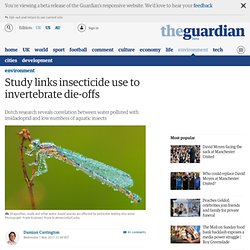
On Monday, the insecticide and two others were banned for two years from use on some crops across the European Union, due to the risk posed to bees and other pollinators, on which many food crops rely. However, much tougher action in the form of a total worldwide ban is needed, according to the scientist who led the new study.
"We are risking far too much to combat a few insect pests that might threaten agriculture," said Dr Jeroen van der Sluijs at Utrecht University. "This substance should be phased out internationally as soon as possible. " The pollution was so bad in some places that the ditch water in fields could have been used as an effective pesticide, he said. Bijensterfte: Superinsecticide Imidacloprid heeft dramatische gevolgen voor insectenrijkdom in en om het water. Persbericht 2 mei 2013 - Utrechtse Wetenschappers luiden de internationale noodklok Er vliegen de laatste jaren steeds minder insecten rond.
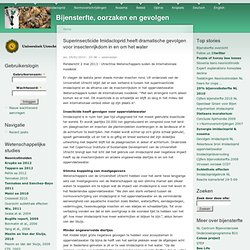
Uit onderzoek van de Universiteit Utrecht blijkt dat er een verband is tussen het superinsecticide imidacloprid en de afname van de insectenrijkdom in het oppervlaktewater. Wetenschappers luiden de internationale noodklok: “Met een strengere norm alleen komen we er niet. Dit insecticide is zo schadelijk en blijft zo lang in het milieu dat een internationaal verbod zeker op zijn plaats is”. Insecticide heeft gevolgen voor oppervlaktewater Imidacloprid is in ruim tien jaar tijd uitgegroeid tot het meest gebruikte insecticide ter wereld. Slimme koppeling van meetgegevens Wetenschappers van de Universiteit Utrecht hebben voor het eerst twee langjarige sets van meetgegevens van de Waterschappen op een slimme manier aan elkaar weten te koppelen om te kijken wat de impact van imidacloprid is voor het leven in het Nederlandse oppervlaktewater.
British moths in calamitous decline, major new study reveals. Moths are vanishing from our skies at night, declining in southern Britain by 40% over 40 years, a major new report published on Friday reveals.
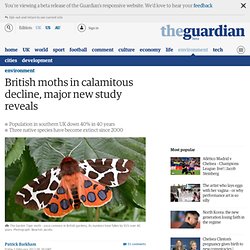
Three species have become extinct this century already, following the permanent loss of 62 species in the twentieth century. The calamitous and largely hidden effect of human activities on these crucial insect populations has been exposed by light traps set in more than 525 sites across the country, which captured nine million moths between 1968 and 2007. Two-thirds of common and widespread larger moths have declined over this 40-year period, with the Orange Upperwing, Bordered Gothic and Brighton Wainscot all becoming extinct in the last 10 years. Once-common species such as the V moth are now in danger of extinction after suffering a 99% decline, according to The State of Britain's Larger Moths 2013, a new report by Butterfly Conservation and Rothamsted Research, an independent research organisation. Beetle declines increase concerns about wider insect trouble.
Lift a rock or log anywhere in the country and chances are you'll see beetles from many species scurrying beneath it.
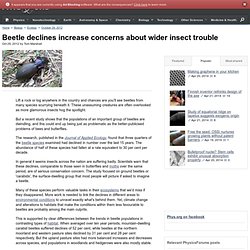
These unassuming creatures are often overlooked as more glamorous insects hog the spotlight. Shocking decline seen in birds that eat insects in flight. FAIRFIELD -- Since the 1970s, the many species of birds that hunt insects in flight have seen their populations drop by 80 percent or more, and no one knows why.

On Friday, the Connecticut Audubon Society presented its eighth annual Connecticut State of the Birds 2013 report, which this year looks at the alarming condition of the so-called "aerial insectivores," the birds and bats that catch insects in mid-air, as opposed to foraging on the ground or on plants. "They're disappearing much faster than any of the threatened perching birds," said avian scientist Shannon Kearney-McGee, of the state Department of Energy and Environmental Protection, who co-authored the report with nine other biologists and researchers.
"So there is something going on, and this is a Northeast-focused decline. " Bad news for Europe’s bumblebees. 02 April 2014 | International news release Twenty four percent of European bumblebee species are threatened with extinction according to a recent study assessing the species group at the European level.

The study examines all of the 68 bumblebee species that occur in Europe. It is part of the Status and Trends of European Pollinators (STEP) project and the European Red List of pollinators, both funded by the European Commission. The results feed into The IUCN Red List of Threatened Species™. Bumblebees, like other pollinators, play a critical role in securing food production. “We are very concerned with these findings. According to the study, 46% of bumblebee species in Europe have a declining population, 29% are stable and 13% are increasing. “The plight of Europe's bumblebees is a problem that needs to be tackled on all fronts. Climate change, through increasing temperatures and long periods of drought, is responsible for major changes in bumblebee habitat.
Pesticides: Biodiversity at risk. This week's edition of Nature magazine brings a chilling article on the horrendous effects of agricultural chemicals in pesticides on invertebrates and the soil.
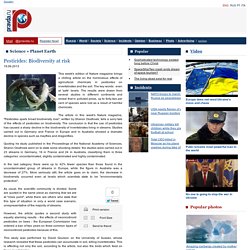
The key words: even at 'safe' levels. The horrendous effects of pesticides on invertebrates. Ökolandbau Seite 2.